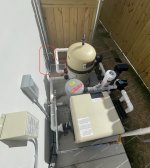- Jan 22, 2022
- 213
- Pool Size
- 10000
- Surface
- Plaster
- Chlorine
- Salt Water Generator
- SWG Type
- Pentair Intellichlor IC-40
Our PB added a filler line that come out of one of our skimmer basket spots and it is T’d off of the hose bib by our equipment pad. It’s a 1” pvc line and it’s honestly nice to not have to drag the hose to the pool when I need to top off every month or so. Lately though over the summer I’ve been noticing a terrible smell (like rotten eggs/sulfur) smell from the water when I use that line. I’m assuming it’s just stagnant water that was sitting in the line along with any bugs or dirt that washed in between fills but it’s a pretty rotten smell. Usually goes away after a few minutes and doesn’t linger into the pool water later on.
It got me thinking though, is there any harm of this nasty smelling water going into the pool as far as chemical balance and algae production? Should I just use the hose instead to be safe or am I overthinking this? Thanks!
It got me thinking though, is there any harm of this nasty smelling water going into the pool as far as chemical balance and algae production? Should I just use the hose instead to be safe or am I overthinking this? Thanks!



